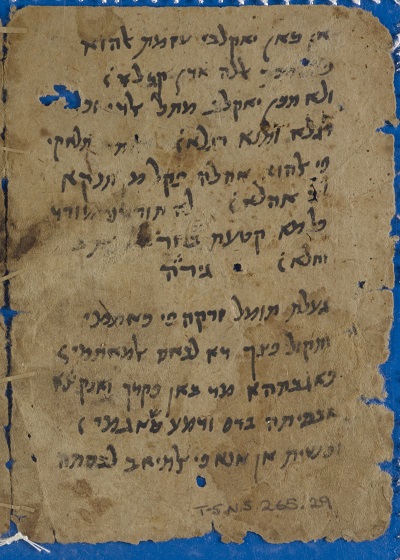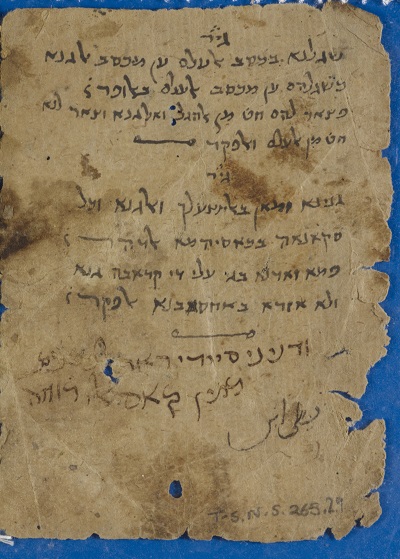Six Centuries of Arab Poets Transmitted in a Booklet of Judaeo-Arabic Poetry[1]
Gretchen E. Belnap (University of Cambridge/Woolf Institute)
While working on my MPhil dissertation at the University of Cambridge, I had the privilege of studying some previously unexamined Judaeo-Arabic poetry in the Cairo Genizah. With the help of Dr Esther-Miriam Wagner, Dr Mohamed Ahmed and the tools available at the Friedberg Genizah website, I discovered a connection between two manuscripts conserved separately: T-S NS 265.29 and T-S Ar.13.2. The join between the two was confirmed when we identified the first line on a folio in T-S Ar.13.2 as the last line of a poem begun in T-S NS 265.29, which is attributed to the tenth century panegyricist popularly known as Kushājim.
In working with these two previously unedited folios we discovered material by a range of authors, most from the ninth and tenth centuries. However, this booklet of poems contains authors as diverse as the pre-Islamic poet Ḥātim al-Ṭāʾī (d. late sixth century), the ninth century renunciant Maḥmūd al-Warrāq (d. 845), the Shiite poet-prince Abū Firās al-Ḥamdānī (d. 968), and Ibn al-Nabīh (d. 1222), a composer of praise poetry for prominent members of the Ayyubid court. As with the sampling of authors, the thematic arc of the content is equally broad. These poems range from ghazals depicting separation from a beloved to ruminations on the soul and denouncements of wealth in favour of poverty. The booklet of poems at hand is dated to somewhere between the eleventh to the thirteenth centuries, which falls within the Classical Period of Genizah manuscripts. The material of the folios (paper), the orthographic conventions manifest therein, and the date range of poets represented in the collection all factor into this estimate.
I would like to highlight a few of the poems contained in these two folios, beginning with the poem by Kushājim. Kushājim, formally known as Abū al-Fatḥ Maḥmūd ibn al-Ḥusayn ibn Shāhak, worked in the Ḥamdānid court in Aleppo and is recognized for his contributions to nature poetry. The poem in our folio, however, is neither a panegyric nor a meditation on nature, but rather an esoteric exchange between two speakers involving images of funeral garb, mourning, and a (perplexing) signet ring. The Judaeo-Arabic copy of the poem in TS N-S 265.29 (1v) reads:
T-S NS 265.29 folio 1v
געלת תומל זרקה פי כאתמי
ותקול פצך דא לבאס אלמאתמי:
פאגבתהא מד כאן פקדך ואנקצּא
אבכיתה בדם ודמע סאגמי:
וכשית אן אנא פי אלתיאב לבסתה
אן יפטנו פלבסתה פי אלכאתמי
Translation (my own):
She began to contemplate the blue (gem) of my ring
And says “your gem embodies funeral garb”
And I answered her, since your absence
I wept (for it) in blood and streaming tears
And feared that if I put on the (funeral) robe,
They would realize, so I’m wearing it (his mourning) in the ring.
The Arabic version preserved in the Diwan of Kushājim reads: [2]
جَــعَـلَتْ تَـأَمَّل زُرْقَـةً فِـي خَـاتَـمِـي وَتَـقُـولُ فَـصُّكَ ذَا لِبَاسُ المَأْتَمِ
فَـأَجَـبْـتُـهَا مُذْ مَاتَ وَصْلُكِ وانْقَضَى بَــكَّيــْتُــهُ بِــدَمٍ وَدَمْــعٍ سَــاجِـمِ
وَرَغِــبْــتُ فِـي لُبْـسِ الحِـدَادِ لِأَنَّهُ لُبْسُ الحَزِيْنَةِ وَالحَزِيْنِ الهَائِمِ
وَخَشِيْتُ إِنْ أَنَا فِي الثِّيَابِ لَبِسْتُهُ أَنْ يَـفْـطِنُوا فَلَبِسْتُهُ فِي خَاتَمِي
The text of the Judaeo-Arabic and that of the Arabic are fairly consistent with each other, with minor linguistic variations. However, the third line of the Arabic text (وَرَغِــبْــتُ...) is not found in the Judaeo-Arabic edition. The dominant theme of the poem seems to be the man’s preoccupation with concealing his mourning, the meaning of which is enigmatic.
Another of the poems copied in T-S NS 265.29 is attested in a collection of verse gathered by the noted Persian anthologist al-Thaʿālibī (d. 1038) known as Yatīmat al-dahr fī maḥāsin ahl al-ʿaṣr. Al-Thaʿālibī’s anthology was innovative as a “geographic survey” of poets, allowing literature to be studied and referenced by “city, region, and court.” (Urfahʹlī, Bilāl, The Anthologist's Art: Abū Manṣūr al-Tha'ālibī and His Yatīmat al-dahr, 29-30.) His structure influenced major anthologies that followed, including Kharīdat al-qaṣr wa-jarīdat al-ʿaṣr, compiled by ʿImād al-Dīn al-Kātib al-Iṣfahānī (d. 597/1201).
The poem in our fragments is attributed to Abū Sahl ibn Asbāt al-Kātib, about whom little biographical information is available. The Judaeo-Arabic version of the poem in T-S NS 265.29 (1v) reads:
אן כאן יאקלבי עזמת אלהוא
פ[אסתכר] אללה אדן קבלא:
ולא תכן יאקלב מתל אלדי ו[כא]
רגלא ותנא רגלא: חתי תלאקי
פי אלהוא אהלה פקל מן תלקא
לה אהלא: לא תורדני מורד
כל מא קטעת בחר …]]
וחלא
Translation (my own):
If, my heart, you are resolved to love
Then seek counsel from God first
Oh heart, do not be like the man who extends
One leg and bends the other: So that you may encounter
The people of love, and few are they who find
Them; Do not put me in a place
Where every time I cross an ocean I encounter
A swamp
The version anthologized in al-Thaʿālibī's collection reads:[3]
إن كنت يا قلب عزمت الهوى فاستخر الله إذا قبلا
ولا تكن يا قلب مثل الذي قدم رجلاً وثنى رجلا
حتى تلاقي في الهوى أهله وقلما تلقى له أهلا
لا توردني مورداً كلما قطعت وحلاً ألتقى وحلا
The edition in al-Thaʿālibī is fairly consistent with the Judaeo-Arabic text. However, a significant lexical variation between the two amounts to the difference between “a sea” and “a swamp”. In the Judaeo-Arabic, the poet pleads: “Do not put me in a place/ Where every time I cross an ocean I encounter/ A swamp.” In al-Thaʿālibī’s edition, the speaker crosses a swamp only to find himself in another swamp. Both versions seem plausible, though each yields a different meaning. However, the conclusion in both versions seems to imply a sense of disappointment or possibly futility.
The poem by the pre-Islamic poet Ḥātim al-Ṭāʾī (d. late sixth century) found in T-S NS 265.29 (2v) raises many questions, as it appears to be excerpted from a longer work by al-Ṭāʾī.[4] The full work in al-Ṭāʾī’s dīwān is comprised of 20 lines; the Judaeo-Arabic edition corresponds to portions of lines 15-17, though with significant lexical variation. It reads:
T-S NS 265.29 folio 2v
גנינא זמאן באלתצעלך ואלגנא וכל
סקאנאה בכאסיה מן אלדהר:
פמא זאדנא בא עלי די קראבה גנא
ולא אזדא באחסאבנא אלפקר:
Translation (my own):
We have spent our time in wealth or poverty—for each
Fate has filled the cup
Our arrogance toward our relatives will not increase because of our wealth
As there is nothing surpassing what we have gained from poverty
The Judaeo-Arabic recension in our folio differs significantly from the corresponding section of the poem in the Arabic of al-Ṭāʾī’s Dīwān, which reads:[5]
عُنينا زماناً بالتّصَعْلُكِ والغِنى كما الدهر في أيامه العسر واليسرُ
كَسَينا صرُوفَ الدّهرِ لِيناً وغِلظَةً وكلاً سقاناه بكأسيهما الدهرُ
فما زادنا بأواً على ذي قرابة ٍ غِنانا ولا أزرى بأحسابِنا الفقرُ
While al-Ṭāʾī’s poem treats various virtues, it is clear that our copyist here was most concerned with those of poverty and modesty. Of all the poems in these two folios, this text seems to most clearly exhibit aspects of recension, providing an example of how Arabic poetry was received among certain members of the Jewish community in High Medieval Egypt.
While the material throughout these folios is diverse, there are patterns of mystical and ascetic elements which surface throughout. In this small sampling of Judaeo-Arabic poetry, we get a picture of what types of Arabic poetry may have been of interest to members of the Cairene Jewish community—and perhaps gain insight into what poetry may have been in broader circulation. Through comparing different editions of the same poetic text we gain perspective into the function or use of such texts among a Jewish readership. As with the lines excerpted from a longer work by al-Ṭāʾī found in T-S NS 265.29 (2v), the omission of various passages amounts to a kind of “Judaized abridgement,” giving us a picture of “how Muslim religious or ethical texts were adapted for Jewish use.”[6] I believe that similar dynamics apply in the context of poetic recensions. In this sense, Judaeo-Arabic poetry in the Genizah may yield insights far beyond the poetic texts they transmit.
Footnotes
[1] I gratefully acknowledge the help of Dr Esther-Miriam Wagner and Dr Mohamed Ahmed, who provided crucial guidance in reading the poetic texts and in searching for the poems in online Arabic poetry collections, at all stages of this project. Their help in the transcription, translation, and interpretation of these verses was indispensable. I am also grateful to Dr Nathaniel Miller for drawing my attention to T-S Ar.13.2 and for his invaluable advice on the poems.
[2] Kushājim, Maḥmūd ibn al-Ḥusayn, Dīwān (Beirut: Dār al-Kutub al-ʿIlmiyya, 1998), 166-67.
[3] Abū Manṣūr al-Thaʿālibī, Yatīmat al-dahr fī maḥāsin ahl al-ʻaṣr vol. 1 (Beirut: Dār al-Kutub al-ʿIlmiyya, 1983), 519.
[4] See Ḥātim al-Ṭaʾī, Dīwān. Beirut: Dār Ṣādir, 1981, 50-51.
[5] Ḥātim al-Ṭāʾī, Dīwān (Beirut: Dār Ṣādir, 1981), 50-51.
[6] Fenton, “Kitâb ad-Durr,” 217.
Cite this article
(2018). Six Centuries of Arab Poets Transmitted in a Booklet of Judaeo-Arabic Poetry. [Genizah Research Unit, Fragment of the Month, September 2018]. https://doi.org/10.17863/CAM.34054
If you enjoyed this Fragment of the Month, you can find others here.
Contact us: genizah@lib.cam.ac.uk
The zoomable images are produced using Cloud Zoom, a jQueryimage zoom plugin:
Cloud Zoom, Copyright (c) 2010, R Cecco, www.professorcloud.com
Licensed under the MIT License


